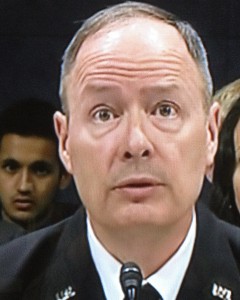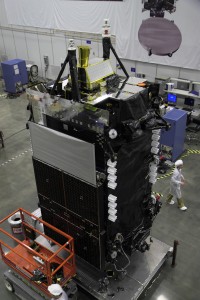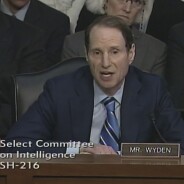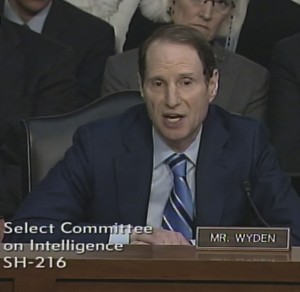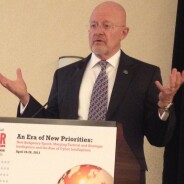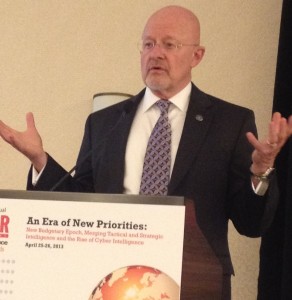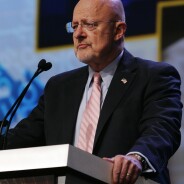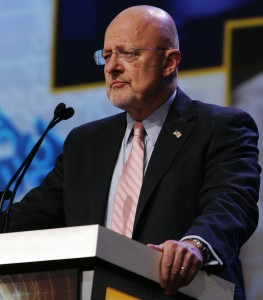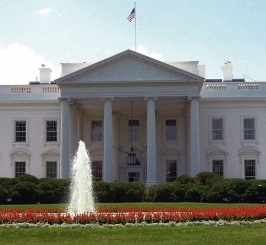News
Three myths from the leak fallout
We should watch out for pesky urban legends as the country reconsiders its intelligence strategy after the Snowden leaks. Here are some myths I see brewing:
1. Experts know best >> As surprising as it is, research by psychologist Philip Tetlock shows that experts don't do a very good job of predicting outcomes. That's a good argument for debating the nation’s broad intelligence strategies in open forums. By broad strategies, I mean things like interrogation techniques and domestic surveillance.
In Tetlock’s parlance, there are two kinds of people involved in decision making. Hedgehogs are people with specific knowledge, and foxes are those with knowledge of many things. The debate over the country’s surveillance strategy was run by hedgehogs in each branch of government. We shouldn’t assume that these people accurately assessed the outcomes of collecting massive amounts of data. Did anyone compare the security benefits of a dollar spent storing telephone metadata versus a dollar spent sweeping up weapons of mass destruction around the world through the Defense Threat Reduction Agency? Or a dollar spent on more analysts and better software for them? Or a dollar spent on human intelligence? I fear not.
2. More surveillance would have prevented the 9/11 attacks >> Lots of things could have prevented the attacks. The FBI could have shared its suspicions about Zacarias Moussaoui and his flight training in Minnesota. The Bush administration could have acted on the activities “consistent with preparations for hijackings” recounted in the Aug. 6, 2001 Presidential Daily Brief. It could have acted on the CIA's reference to a possible attack in New York. Someone could have blown the whistle to the intelligence committees or the media. More surveillance would have idiot proofed the pre-9/11 intelligence, but we shouldn’t need idiot proofing. We were left vulnerable by a failure to share information more than anything else.
3. Using contractors invites leaks >> Bradley Manning, the suspected source of the Wikileaks documents, was a soldier not a contractor. Contractors have “the same level of security clearance and the same process for securing them,” NSA Director Gen. Keith Alexander told lawmakers at a June 18 hearing. That said, there are reasons other than leaks to take a fresh look at the scale of our reliance on contractors. See, for example, “Put the Spies Back Under One Roof" in the New York Times. A big problem is that contractors don’t always have the same skills and training as their government counterparts. Lt. Gen. Michael Flynn, the DIA director, is trying to synchronize training for all analysts at his agency under a new course called PACE for Professional Analyst Career Education.
Wartime comms innovation gets more funds
Wars always raise questions about which novel equipment will outlive the fighting that spawned them, and among the survivors of the war in Afghanistan could be the Iridium satellite radios rushed there starting in 2010.
ITT Exelis received a $5 million contract from the Defense Information Systems Agency last month to show how the Iridium-based Distributed Tactical Communications System -- also known as Netted Iridium -- could be expanded globally and with a shorter voice latency.
Iridium is best known as a satellite telephone service for rich yachters, but when troops and operatives in Afghanistan needed to talk in rugged terrain, the Pentagon was desperate. ITT – now ITT Exelis – was hired to manufacture simple, push-to-talk radios that could communicate over the commercial Iridium constellation.
Today, DTCS radio networks can be set up regionally to provide communications out to ranges of 250 to 500 miles. The first networks were set up in Afghanistan, but the radios have also been used in Africa and the Pacific Command area.
By reprogramming the radios, ITT Exelis thinks it can give users global reach and open the door to lots of new applications. Unattended ground sensors could be linked to data networks; GPS locations could be transmitted to track supplies; the locations of DTCS users could be displayed to commanders or intelligence managers thousands of miles away, because the radios have GPS receivers in them.
The company will have a chance to prove at least some of those capabilities in a series of demonstrations next year at the Naval Surface Warfare Center in Dahlgren, Va. The dates for the demos are to-be-decided, DISA said in prepared statement that did not spell out what would be done in the demos.
If all goes as planned, users in remote locations -- say, somewhere in the Pacific Command region –- could communicate with their bosses back in the continental U.S. “They can reach out, they can talk. They would be netted,” said Dario Valli, a retired Marine and business development manager for specialty applications at ITT Exelis Electronic Systems in Dulles, Va.
Then there's the latency issue. Right now, someone pushes a button and speaks into a DTCS radio, and the user on the other end hears the voice about 1.5 seconds later. ITT Exelis wants to get that down to a second or less.
DTCS was rushed to the field as a quick answer to a joint urgent operational needs request from commanders in Afghanistan. Leaders of small military units and intelligence operatives were frustrated they couldn't communicate reliably in the remote places they were doing their counter-insurgency work. Mountains or structures blocked terrestrial radio signals, and the Taliban made it all but suicidal to stand on a ridge pointing an antenna at a geosynchronous satellite parked high over the equator.
Iridium’s satellites are easier to connect with. Sixty-six of them circle from pole to pole in low-Earth orbit. “Now it’s the satellites that are moving around (users) as they maneuver and operate in a variety of environments,” Valli explained. Comms will be there "as long as they have a view to the sky," he said.
Engineers had to figure out how to make one Iridium satellite hand-off radio voice comms to the next as they moved across the sky. That was possible because the satellites already have communications crosslinks.
ITT Exelis has made about 8,000 of the radios at a cost of about $4,500 each. If the demonstration goes well, new software would be installed in these radios in the field to give them global connectivity.
Exelis calls the devices RO Radios, which is short for Radio Only. Valli said that’s an anachronism given that the radios also feed position locations to the military’s force tracking network.
Other changes could also be in store. DISA has insisted on open standards going forward, which means multiple companies could end up making handsets or other kinds of devices. “There’s a host of applications beyond just the tactical radio that can take advantage of this architecture that DISA is developing,” Valli said.
DTCS can't do everything. It isn’t meant for broadband communications, and it wouldn't be an alternative to the constellation of Mobile User Objective System geosynchronous satellites the Navy is setting up for the military services and the intelligence community. Neither would it supplant smartphones and deployable cell networks on the battlefield.
It’s main purpose is a specific one: To let users venture deep into the field with nothing more than what’s on their backs: “You can plan your operations only as far as you can command and control,” Valli said.
NSA: Surveillance helped stop 50 attacks
The collections programs leaked by former NSA system administrator Edward Snowden helped the U.S. disrupt more than 50 potential terror attacks, NSA Director Gen. Keith Alexander told lawmakers today. Ten of the cases involved "homeland-based threats," Alexander said in a rare open session of the House Permanent Select Committee on Intelligence.
But don't expect to hear details of those cases.
Alexander said all but four examples discussed publicly by U.S. officials would remain classified. He said saying more about tactics in public would “give our adversaries ways to work around those and attack us or our allies."
Alexander said the intelligence community is still working to finalize the precise number of defused attacks, and that a packet of of information would be delivered tomorrow to the House and Senate intelligence committees.
The hearing gave Alexander and top officials from the FBI, Justice Department and Office of the Director of National Intelligence an opportunity to justify the programs. It was entitled, "How Disclosed NSA Programs Protect Americans, and Why Disclosure Aids Our Adversaries."
Rep. Jan Schakowsky, D-Ill., said she believes the unclassified conversation that played out in the hearing could have been had "up front," meaning long before the Snowden leaks.
Most of the hearing explored the merits of the surveillance programs revealed by Snowden, but Alexander also addressed security. He said NSA would be implementing a "two-person control" system for administrators like Snowden.
That approach is widely used for security in the banking world. "It sounds like what he is talking about is literally requiring two people to be involved in making any type of system configuration change," said Christopher Trautwein, chief information security officer for the International Information Systems Security Certification Consortium, or (ISC)2, which certifies IT workers. "It’s kind of similar to the segregation of duties that would happen in a financial world."
Another way to reduce the risk of leaks would be to cut the number of system administrators. Alexander said that could be done through the community's IT modernization effort. It will include a common operating system across the community. Alexander appeared to call for acceleration of ICITE, the Intelligence Community Information Technology Enterprise.
"If we could jump to that immediately I think that would get us a much more secure environment, and would reduce this set of problems," he said.
ICITE is a troubled program. Roll out of an initial version at two agencies has slipped five months, and the community hasn't established how it will pay for implementing it across all 17 intelligence agencies.
Hearing excerpts >>
Alexander on "Critical leads" >>
“As we stated, these programs are immensely valuable for protecting our nation and securing the security of our allies. In recent years, the information gathered from these programs provided the U.S. government with critical leads to help prevent over 50 terrorist events in more than 20 countries around the world. FAA (Foreign Intelligence Surveillance Act Amendments Act of 2008) 702 contributed in over 90 percent of these cases. At least 10 of these events included homeland-based threats. In the vast majority, business records FISA reporting contributed as well. I would also point out that it is a great partnership with the Department of Homeland Security in those with a domestic nexus."
Alexander on security improvements >>
• "I talked to our technology directorate about the two-person control for system administrators to make any change. We are going to implement that..."
• "...you may recall that the intelligence community looked at a new information technology environment that reduces the number of system administrators. If we could jump to that immediately I think that would get us a much more secure environment, and would reduce this set of problems. It’s something that the DNI is leading and that we’re supporting, as you know across the community. I think that is absolutely vital to get to.
Schakowsky says better to talk "up front" >>
"...we would have been better off at having a discussion of vigorous oversight, the legal framework, et cetera, up front, and how this could prevent perhaps another 9/11, and in fact, 50 or so, attacks."
Alexander says no " rogue operation" >>
“This isn’t some rogue operation that a group of guys up at NSA are running. This is something that has oversight by the committees, the courts, the administration, and a hundred percent auditable process under business records."
ANALYSIS: Avoiding the China comsat trap
You know the legislative season is in full swing when the annual tough talk about China morphs into bill language. Wording in the House version of the National Defense Authorization Act would require gobs of paperwork – including an assessment by the director of national intelligence -- before the military ever again leases satellite bandwidth from a company owned partly by China. For good measure, the bill tosses in North Korea and any countries on the U.S. list of state sponsors of terrorism.
The wording sprang from news earlier this year that the U.S. military needed more satellite coverage in Africa, so it indirectly leased capacity from a satellite owned partly by China.
Underlying this controversy is a bit of acquisition bureaucracy that will probably never make a Tom Clancy novel. The U.S. pays for commercial bandwidth under a complicated approach that treats commercial satcom as a service that can be lined up whenever the military finds itself in a pinch.
Those who don’t like that approach, including retired Air Force Brig. Gen. Tip Osterthaler, are seizing the China satcom controversy as an opportunity to argue for a new way of doing business.
Osterthaler is CEO of SES Government Solutions of McLean, Va. His company exists to lease satcom capacity to the Defense Department and other U.S. agencies from a fleet of commercial satellites operated by SES of Luxembourg.
Today, the U.S. General Services Administration and the Defense Information Systems Agency jointly maintain two lists of approved satcom providers under an initiative called the Future Comsatcom Services Acquisition. One list is used for leasing bandwidth, and it's known as SIN 54, short for special item number 54. The other list, SIN 55, has 29 companies, and it’s for subscription services. Some companies are on both lists, including Osterthaler’s.
SES and other companies are making good money, but the downside in Ostherthaler’s view is that good commercial solutions aren't always available to the government.
“As long as you’re buying satcom out of IDIQ contracts” – multi-year indefinite delivery/indefinite quantity agreements – “you’re necessarily buying out of existing inventory, and you’re stuck with whatever is on the menu,” he says.
When the White House decided to get serious about countering Islamic militants in Africa last year, the best choice on the comsat menu was a satellite called Apstar 7. It’s parked in geosynchronous orbit over the Indian Ocean, and is operated by APT Satellite Holdings of Hong Kong. APT is 36 percent owned by the Chinese government’s China Aerospace Science and Technology Corporation.
APT isn’t one of the Defense Department's approved contractors, but a company called Harris Caprock of Fairfax, Va., is. Harris Caprock doesn’t own or operate any satellites. It leases raw capacity from fleet operators and incorporates that capacity into end-to-end communications offerings. Harris Caprock arranged for military communications to flow over Apstar 7 as part of its successful Africa comms bid. In a prepared statement, the company says all its offerings must meet the Defense Department’s “stringent information assurance standards.”
For its part, APT insists its satellites aren’t controlled by China: “We are a separate, independent corporation; we operate independently,” says Brian Lo, APT’s spokesman. That’s a tough sell to lawmakers alarmed by China’s alleged cyber espionage and theft of intellectual property.
In Osterthaler’s view, the risk to the U.S. isn’t so much that China could eavesdrop on military comms. Any sensitive U.S. information flowing over Apstar 7’s transponders would be sent as heavily encrypted streams of ones and zeros. The bigger risk is that China could gain leverage in a political or military crisis by using its influence over APT’s transponders to say, “Just shut 'em down, take them off the air,” Osterthaler says.
The Apstar 7 issue was thrust onto the public record during an April hearing, when Rep. Mike Rogers, an Alabama Republican, asked a Pentagon official about any agreements “in which the People’s Republic of China has significant ownership interest.”
Doug Loverro, the deputy assistant secretary of defense for space policy, said he learned about the China satcom leases only when he arrived at his new position about a month earlier.
Osterthaler thinks he knows how the Pentagon can avoid ending up on the hotseat again. He wants the military to throw out the services approach for satcom in favor of integrating the commercial players into its long-term communications planning.
“We’re going around and around on how to improve the way we acquire services,” Osterthaler says. “Even if we fix services, it’s going to take a long time, it’s going to be imprecise, and it might not even be broken” for things like “pencils” and “janitorial services,” he says.
Osterthaler wants the Defense Department to be given the authority to tell satellite operators how much throughput they expect to need in future years in specific geographic regions. Commercial satcom providers could then compete to satisfy that demand.
Government antennas could be installed on new commercial satellites as hosted payloads. Free-flying small satellites could be built for government use. Exclusive access could be offered to steerable beams that boost capacity where it’s needed.
Here’s the tricky part: “The common feature of all of these kinds of arrangements is that the Department would actually have to make a commitment in order for the commercial satellite company to make the investment,” Osterthaler says.
If nothing is done, he thinks Congress and the Pentagon will end up with more Apstar 7-like dilemmas.
“We’d probably all be surprised if we looked at the number of times that contracts were awarded on satellites that people might think ought to be subject to review, oversight and limitation,” he says. “If we don’t like that, we need to pursue some logical alternatives so we can get out of this situation that we’re in.”
What’s the best way to judge cyber skills?
Most information security workers in the U.S. are judged by the certifications they hold, and those certifications are earned by taking exams administered by a handful of independent groups. Not everyone's convinced that asking questions is sufficient to measure the skills of thousands of cyber professionals at NSA, Cyber Command and other agencies.
Among them are experts at the Maryland information company TeleCommunication Systems. TCS has developed a software tool that lets agencies assess the performance of workers as they pluck their way through live test scenarios in carefully controlled cyber sandboxes.
The TCS software, called PerformanScore, is among a new breed of “keyloggers on steroids,” said NIST’s Ernest McDuffie, leader of the U.S. National Initiative for Cybersecurity Education, which is working to improve the U.S. cyber workforce.
The arrival of the TCS tool is likely to fire up the debate over written tests versus hands on exercises, a debate that McDuffie said shouldn’t be a debate at all.
“It’s really not an either or situation. You want to do both,” he said. An exam is best for testing knowledge, while a lab exercise is better for assessing a worker’s ability to work under time pressure, McDuffie said.
TCS hopes to license and install the new software for government customers.
“We can validate that the person’s not just book smart,” said Dan Callahan, product manager at TCS’ Art of Exploitation center in Hanover, Md. As an example, he said the software records the commands a worker would type to scan a network for vulnerabilities during penetration testing.
TCS won’t talk about specific customers, but its exploitation center is located about eight miles from Fort Meade, home to NSA and U.S. Cyber Command.
TCS says it has no visions of putting any certification organizations out of business. “Some of those certification bodies are our friends,” Callahan said.
But Callahan said TCS has gotten feedback that the certifications alone are “too broad” to prove “that these guys have the necessary skills and abilities to do that job.”
It’s not a consensus view.
The power of a detailed exam shouldn’t be underestimated, said W. Hord Tipton, executive director of the 90,000-member International Information Systems Security Certification Consortium, or (ISC)2.
“You get a slice of what the person is doing with your lab exercise,” but with “a well-thought-out, well-designed written exam, you get the full scope of what they’re capable of,” Tipton said. That's how his group certifies information security professionals.
Tipton said (ISC)2 just finished weighing whether to include lab exercises in its new Certified Cyber Forensics Professional certification designed for litigation consultants, cyber intelligence analysts and others.
(ISC)2 sought advice on the lab question from experts at FBI and CIA and from universities and organizations in Hong Kong, India, and South Korea. The experts concluded “we can gather all of that information through properly designed scenario-based questions,” Tipton said.
Tipton's organization conceived the certification with experts in South Korea who are now adapting the forensics exam to reflect South Korean laws and regulations. That should be done by October, Tipton said.
Wyden: Clapper question was no trick
One could practically hear the neurons firing inside James R. Clapper’s head when Sen. Ron Wyden, D-Oregon, put him on the spot in March about whether the U.S. was collecting “any type of data at all” on millions of Americans.
The national intelligence director at first said, “No sir,” paused when Wyden sounded surprised, and added, “not wittingly...”
Since then, the blogosphere has debated whether the question amounted to a nasty trap because the truth was still highly classified at that point. In a statement released today, Wyden said the question was a direct one and that the director should have known it was coming:
“…I sent the question to Director Clapper's office a day in advance,” and “my staff and I gave his office a chance to amend his answer,” Wyden said.
Wyden called for public hearings on the disclosures, and he described his exchange with Clapper as a low mark for congressional oversight: “This job cannot be done responsibly if Senators aren’t getting straight answers to direct questions.”
Text of Wyden statement >>
“One of the most important responsibilities a Senator has is oversight of the intelligence community. This job cannot be done responsibly if Senators aren’t getting straight answers to direct questions. When NSA Director Alexander failed to clarify previous public statements about domestic surveillance, it was necessary to put the question to the Director of National Intelligence. So that he would be prepared to answer, I sent the question to Director Clapper’s office a day in advance. After the hearing was over my staff and I gave his office a chance to amend his answer. Now public hearings are needed to address the recent disclosures and the American people have the right to expect straight answers from the intelligence leadership to the questions asked by their representatives.”
OPINION: Lessons from the leak
It's easy to see how a Congress determined to avoid another 9/11 could give a thumbs up to two far-reaching surveillance programs. No one wants another terror attack, and the programs were so classified that lawmakers couldn't get sanity checks from their staffs, lawyers and old-fashioned pillow talk. Group think prevailed.
Now that the secrets are out, some lawmakers seem flummoxed: What did we think the Patriot Act, the FISA amendments and big data were anyway?
What's hardest to understand is why no one flagged these programs for the sheer implausibility of keeping them secret. The lesson of this saga is that a public debate will come one way or the other when the issue goes to the heart of America's character. These surveillance programs are an element of our national strategy on a par with drone strikes and treatment of detainees. Those secrets were impossible to keep too.
If Congress or the Obama administration had taken the bold step of making the surveillance conversation public, we could have fast forwarded to the debate sparked by a 29-year-old system administrator named Edward Snowden. A public debate would have been ugly, for sure, but that's the hallmark of the democracy we claim to cherish. Fewer operational details probably would have been released, and the media "misimpressions" cited by Director of National Intelligence James R. Clapper could have been avoided or at least debated upfront.
Clapper has said adversaries will change their behaviors now that these secrets are out, but it's hard to see what exactly they're likely to do differently. Stop using the Internet and telephone? It would be hard to plan attacks without them, which might be a good effect. For some reason, the logic of secrecy doesn't extend to Afghanistan, where the allies acknowledge flying signals intelligence antennas on MC-12 turboprops and drones and depicting the locations of the emitters on digital maps. It makes no sense that Afghans civilians can know the extent of surveillance in their country but Americans can't.
Here's the reality: Agencies can ban thumb drives. They can use high-tech document tracking and network security software. They can give contractors and employees polygraphs. In the end, a wise information assurance strategy must take into account whether a topic or policy should be kept secret in the first place.
But here we are. Snowden's last known location was Hong Kong, where he came across as smart and reasonable in a Guardian video interview, aside from a couple zingers about the “architecture of oppression” and “turn-key tyranny” he thinks we're headed for if we don't listen to him.
We're about to find out whether the U.S. government will treat Snowden as a whistleblower, a criminal or something in between. A "Pardon Edward Snowden" petition showed up on the White House web site on the same day he went public.
Top U.S. officials are wrestling with the contradiction of leaks that can't be tolerated, and a national conversation they must accept.
A few days before Snowden took responsibility, President Obama took a question about the surveillance leaks during an appearance in California, saying, “I welcome this debate and I think it’s healthy for our democracy.” On CBS’s Face the Nation, the Republican chairman of the House Homeland Security Committee, Rep. Michael McCaul of Texas, said the leaks will “give us a chance to provide some additional oversight of what the administration is doing," and then he called them a “serious breach.”
Clapper has been the consistent one. He's condemned the media reports and leaks as “reprehensible” and “reckless," and said NSA has requested a criminal probe.
The administration is going to have to decide whether Snowden should be thanked for starting a necessary debate or tarred as an alleged criminal.
TEXT: Prism defense touts oversight
Director of National Intelligence James R. Clapper has elected to release details of the Prism Internet surveillance program to clear up what he describes as "misimpressions" left by the media's "reckless disclosures." Below are his introductory statement (item 1) and Prism fact sheet (item 2).
1. Clapper statement >>
DIRECTOR OF NATIONAL INTELLIGENCE
WASHINGTON, DC 20511
June 8, 2013
DNI Statement on the Collection of Intelligence Pursuant to Section 702
of the Foreign Intelligence Surveillance Act
Over the last week we have seen reckless disclosures of intelligence community measures used to keep Americans safe. In a rush to publish, media outlets have not given the full context–including the extent to which these programs are overseen by all three branches of government–to these effective tools.
In particular, the surveillance activities published in The Guardian and The Washington Post are lawful and conducted under authorities widely known and discussed, and fully debated and authorized by Congress. Their purpose is to obtain foreign intelligence information, including information necessary to thwart terrorist and cyber attacks against the United States and its allies.
Our ability to discuss these activities is limited by our need to protect intelligence sources and methods. Disclosing information about the specific methods the government uses to collect communications can obviously give our enemies a “playbook” of how to avoid detection. Nonetheless, Section 702 has proven vital to keeping the nation and our allies safe. It continues to be one of our most important tools for the protection of the nation’s security.
However, there are significant misimpressions that have resulted from the recent articles. Not all the inaccuracies can be corrected without further revealing classified information. I have, however, declassified for release the attached details (Editor's note: See item 2 below) about the recent unauthorized disclosures in hope that it will help dispel some of the myths and add necessary context to what has been published.
James R. Clapper, Director of National Intelligence
2. Prism fact sheet >>
DI R E C T O R OF NA T I O N A L I N T E L L I G E N C E
WASHINGTON,DC 20511
June 8, 2013
Facts on the Collection of Intelligence Pursuant to Section 702
of the Foreign Intelligence Surveillance Act
PRISM is not an undisclosed collection or data mining program. It is an internal government computer system used to facilitate the government’s statutorily authorized collection of foreign intelligence information from electronic communication service providers under court supervision, as authorized by Section 702 of the Foreign Intelligence Surveillance Act (FISA) (50 U.S.C. § 1881a). This authority was created by the Congress and has been widely known and publicly discussed since its inception in 2008.
Under Section 702 of FISA, the United States Government does not unilaterally obtain information from the servers of U.S. electronic communication service providers. All such information is obtained with FISA Court approval and with the knowledge of the provider based upon a written directive from the Attorney General and the Director of National Intelligence. In short, Section 702 facilitates the targeted acquisition of foreign intelligence information concerning foreign targets located outside the United States under court oversight. Service providers supply information to the Government when they are lawfully required to do so.
The Government cannot target anyone under the court-approved procedures for Section 702 collection unless there is an appropriate, and documented, foreign intelligence purpose for the acquisition (such as for the prevention of terrorism, hostile cyber activities, or nuclear proliferation) and the foreign target is reasonably believed to be outside the United States. We cannot target even foreign persons overseas without a valid foreign intelligence purpose.
In addition, Section 702 cannot be used to intentionally target any U.S. citizen, or any other
U.S. person, or to intentionally target any person known to be in the United States. Likewise,
Section 702 cannot be used to target a person outside the United States if the purpose is to
acquire information from a person inside the United States.
Finally, the notion that Section 702 activities are not subject to internal and external oversight
is similarly incorrect. Collection of intelligence info
rmation under Section 702 is subject to an extensive oversight regime, incorporating reviews by the Executive, Legislative and Judicial branches.
The Courts
All FISA collection, including collection under Section 702, is overseen and
monitored by the FISA Court, a specially established Federal court comprised of 11 Federal
judges appointed by the Chief Justice of the United States.
o
The FISC must approve targeting and minimization procedures under Section 702
prior to the acquisition of any surveillance information.
Targeting procedures are designed to ensure that an acquisition targets non-U.S. persons reasonably believed to be outside the United States for specific purposes, and also that it does not intentionally acquire a communication when all the parties are known to be inside the US.
Minimization procedures govern how the Intelligence Community (IC) treats the information concerning any U.S. persons whose communications might be incidentally intercepted and regulate the handling of any nonpublic information concerning U.S. persons that is acquired, including whether
information concerning a U.S. person can be disseminated. Significantly, the dissemination of information about U.S. persons is expressly prohibited unless it is necessary to understand foreign intelligence or assess its importance, is evidence of a crime, or indicates a threat of death or serious bodily harm.
The Congress.
After extensive public debate, the Congress reauthorized Section 702 in
December 2012.
o
The law specifically requires a variety of reports about Section 702 to the Congress.
The DNI and AG provide exhaustive semiannual reports assessing compliance with the targeting and minimization procedures.
These reports, along with FISA Court opinions, and a semi-annual
report by the Attorney General are provided to Congress. In short, the information
provided to Congress by the Executive Branch with respect to these activities provides an unprecedented degree of accountability and transparency.
o
In addition, the Congressional Intelligence and Judiciary Committees are regularly briefed on the operation of Section 702.
The Executive.
The Executive Branch, including through its independent Inspectors General,
carries out extensive oversight of the use of Section 702 authorities, which includes regular on-site reviews of how Section 702 authorities are being implemented. These regular reviews are documented in reports produced to Congress. Targeting decisions are reviewed by ODNI and DOJ.
o
Communications collected under Section 702 have provided the Intelligence
Community insight into terrorist networks and plans.
For example, the Intelligence Community acquired information on a terrorist organization’s strategic planning efforts.
o
Communications collected under Section 702 have yielded intelligence regarding proliferation networks and have directly and significantly contributed to successful operations to impede the proliferation of weapons of mass destruction and related technologies.
o
Communications collected under Section 702 have provided significant and unique intelligence regarding potential cyber threats to the United States including specific potential computer network attacks. This insight has led to successful efforts to mitigate these threats.
EXCERPTS: Clapper defends spy programs
Director of National Intelligence James R. Clapper says reporters have put Americans at risk by revealing existence of the Prism Internet surveillance program, and he strongly defends the NSA's gathering of telephone metadata records. Below are excerpts and text of his prepared statements, plus his answer to National Journal when asked how he could answer “No sir” when asked by a senator whether the NSA collects “any type of data at all” on millions of Americans.
On the Verizon phone records >>
• “In order to provide a more thorough understanding of the program, I have directed that certain information related to the “business records” provision of the Foreign Intelligence Surveillance Act be declassified and immediately released to the public.” - June 6 statement (See item 1 below for full text.)
• “The program does not allow the Government to listen in on anyone’s phone calls. The information acquired does not include the content of any communications or the identity of any subscriber. The only type of information acquired under the Court’s order is telephony metadata, such as telephone numbers dialed and length of calls.”
• “The collection is broad in scope because more narrow collection would limit our ability to screen for and identify terrorism-related communications. Acquiring this information allows us to make connections related to terrorist activities over time...”
• "Discussing programs like this publicly will have impact on the behavior of our adversaries and make it more difficult for us to understand their intentions."
Blasting The Guardian and Washington Post for Prism stories >>
“The unauthorized disclosure of information about this important and entirely legal program is reprehensible and risks important protections for the security of Americans.” (See item 2 below for full text.)
Explaining his answer to Sen. Ron Wyden, D-Oregon, during a March hearing >>
"What I said was, the NSA does not voyeuristically pore through U.S. citizens' e-mails. I stand by that.” (Interview with National Journal)
TEXT OF STATEMENTS:
1. Clapper on the Verizon court order:
June 6, 2013
DNI Statement on Recent Unauthorized Disclosures of Classified Information
The highest priority of the Intelligence Community is to work within the constraints of law to collect, analyze and understand information related to potential threats to our national security.
The unauthorized disclosure of a top secret U.S. court document threatens potentially long-lasting and irreversible harm to our ability to identify and respond to the many threats facing our nation.
The article omits key information regarding how a classified intelligence collection program is used to prevent terrorist attacks and the numerous safeguards that protect privacy and civil liberties.
I believe it is important for the American people to understand the limits of this targeted counterterrorism program and the principles that govern its use. In order to provide a more thorough understanding of the program, I have directed that certain information related to the “business records” provision of the Foreign Intelligence Surveillance Act be declassified and immediately released to the public.
The following important facts explain the purpose and limitations of the program:
• The judicial order that was disclosed in the press is used to support a sensitive intelligence collection operation, on which members of Congress have been fully and repeatedly briefed. The classified program has been authorized by all three branches of the Government.
• Although this program has been properly classified, the leak of one order, without any context, has created a misleading impression of how it operates. Accordingly, we have determined to declassify certain limited information about this program.
• The program does not allow the Government to listen in on anyone’s phone calls. The information acquired does not include the content of any communications or the identity of any subscriber. The only type of information acquired under the Court’s order is telephony metadata, such as telephone numbers dialed and length of calls.
• The collection is broad in scope because more narrow collection would limit our ability to screen for and identify terrorism-related communications. Acquiring this information allows us to make connections related to terrorist activities over time. The FISA Court specifically approved this method of collection as lawful, subject to stringent restrictions.
• The information acquired has been part of an overall strategy to protect the nation from terrorist threats to the United States, as it may assist counterterrorism personnel to discover whether known or suspected terrorists have been in contact with other persons who may be engaged in terrorist activities.
• There is a robust legal regime in place governing all activities conducted pursuant to the Foreign Intelligence Surveillance Act, which ensures that those activities comply with the Constitution and laws and appropriately protect privacy and civil liberties. The program at issue here is conducted under authority granted by Congress and is authorized by the Foreign Intelligence Surveillance Court (FISC). By statute, the Court is empowered to determine the legality of the program.
• By order of the FISC, the Government is prohibited from indiscriminately sifting through the telephony metadata acquired under the program. All information that is acquired under this program is subject to strict, court-imposed restrictions on review and handling. The collection is broad in scope because more narrow collection would limit our ability to screen for and identify terrorism-related communications. Acquiring this information allows us to make connections related to terrorist activities over time. Only specially cleared counterterrorism personnel specifically trained in the Court-approved procedures may even access the records.
• All information that is acquired under this order is subject to strict restrictions on handling and is overseen by the Department of Justice and the FISA Court. Only a very small fraction of the records are ever reviewed because the vast majority of the data is not responsive to any terrorism-related query.
• The Court reviews the program approximately every 90 days. DOJ conducts rigorous oversight of the handling of the data received to ensure the applicable restrictions are followed. In addition, DOJ and ODNI regularly review the program implementation to ensure it continues to comply with the law.
• The Patriot Act was signed into law in October 2001 and included authority to compel production of business records and other tangible things relevant to an authorized national security investigation with the approval of the FISC. This provision has subsequently been reauthorized over the course of two Administrations – in 2006 and in 2011. It has been an important investigative tool that has been used over the course of two Administrations, with the authorization and oversight of the FISC and the Congress.
Discussing programs like this publicly will have an impact on the behavior of our adversaries and make it more difficult for us to understand their intentions. Surveillance programs like this one are consistently subject to safeguards that are designed to strike the appropriate balance between national security interests and civil liberties and privacy concerns. I believe it is important to address the misleading impression left by the article and to reassure the American people that the Intelligence Community is committed to respecting the civil liberties and privacy of all American citizens.
James R. Clapper, Director of National Intelligence
2. Clapper addresses Prism program, but not yet by name:
June 6, 2013
DNI Statement on Activities Authorized Under Section 702 of FISA
The Guardian and The Washington Post articles refer to collection of communications pursuant to Section 702 of the Foreign Intelligence Surveillance Act. They contain numerous inaccuracies.
Section 702 is a provision of FISA that is designed to facilitate the acquisition of foreign intelligence information concerning non-U.S. persons located outside the United States. It cannot be used to intentionally target any U.S. citizen, any other U.S. person, or anyone located within the United States.
Activities authorized by Section 702 are subject to oversight by the Foreign Intelligence Surveillance Court, the Executive Branch, and Congress. They involve extensive procedures, specifically approved by the court, to ensure that only non-U.S. persons outside the U.S. are targeted, and that minimize the acquisition, retention and dissemination of incidentally acquired information about U.S. persons.
Section 702 was recently reauthorized by Congress after extensive hearings and debate.
Information collected under this program is among the most important and valuable foreign intelligence information we collect, and is used to protect our nation from a wide variety of threats.
The unauthorized disclosure of information about this important and entirely legal program is reprehensible and risks important protections for the security of Americans.
James R. Clapper, Director of National Intelligence
###
3. Clapper explains decision to release Prism details (See item 4 for fact sheet) released
DIRECTOR OF NATIONAL INTELLIGENCE
WASHINGTON, DC 20511
June 8, 2013
DNI Statement on the Collection of Intelligence Pursuant to Section 702
of the Foreign Intelligence Surveillance Act
Over the last week we have seen reckless disclosures of intelligence community measures used to keep Americans safe. In a rush to publish, media outlets have not given the full context–including the extent to which these programs are overseen by all three branches of government–to these effective tools.
In particular, the surveillance activities published in The Guardian and The Washington Post are lawful and conducted under authorities widely known and discussed, and fully debated and authorized by Congress. Their purpose is to obtain foreign intelligence information, including information necessary to thwart terrorist and cyber attacks against the United States and its allies.
Our ability to discuss these activities is limited by our need to protect intelligence sources and methods. Disclosing information about the specific methods the government uses to collect communications can obviously give our enemies a “playbook” of how to avoid detection. Nonetheless, Section 702 has proven vital to keeping the nation and our allies safe. It continues to be one of our most important tools for the protection of the nation’s security.
However, there are significant misimpressions that have resulted from the recent articles. Not all the inaccuracies can be corrected without further revealing classified information. I have, however, declassified for release the attached details (Editor's note: See item 4 below) about the recent unauthorized disclosures in hope that it will help dispel some of the myths and add necessary context to what has been published.
James R. Clapper, Director of National Intelligence
4. Prism details
DI R E C T O R OF NA T I O N A L IN T E L L I G E N C E
WASHINGTON,DC 20511
June 8, 2013
Facts on the Collection of Intelligence Pursuant to Section 702
of the Foreign Intelligence Surveillance Act
PRISM is not an undisclosed collection or data mining program. It is an internal government computer system used to facilitate the government’s statutorily authorized collection of foreign intelligence information from electronic communication service providers under court supervision, as authorized by Section 702 of the Foreign Intelligence Surveillance Act (FISA) (50 U.S.C. § 1881a). This authority was created by the Congress and has been widely known and publicly discussed since its inception in 2008.
Under Section 702 of FISA, the United States Government does not unilaterally obtain information from the servers of U.S. electronic communication service providers. All such information is obtained with FISA Court approval and with the knowledge of the provider based upon a written directive from the Attorney General and the Director of National Intelligence. In short, Section 702 facilitates the targeted acquisition of foreign intelligence information concerning foreign targets located outside the United States under court oversight. Service providers supply information to the Government when they are lawfully required to do so.
The Government cannot target anyone under the court-approved procedures for Section 702 collection unless there is an appropriate, and documented, foreign intelligence purpose for the acquisition (such as for the prevention of terrorism, hostile cyber activities, or nuclear proliferation) and the foreign target is reasonably believed to be outside the United States. We cannot target even foreign persons overseas without a valid foreign intelligence purpose.
In addition, Section 702 cannot be used to intentionally target any U.S. citizen, or any other
U.S. person, or to intentionally target any person known to be in the United States. Likewise,
Section 702 cannot be used to target a person outside the United States if the purpose is to
acquire information from a person inside the United States.
Finally, the notion that Section 702 activities are not subject to internal and external oversight
is similarly incorrect. Collection of intelligence info
rmation under Section 702 is subject to an extensive oversight regime, incorporating reviews by the Executive, Legislative and Judicial branches.
The Courts
All FISA collection, including collection under Section 702, is overseen and
monitored by the FISA Court, a specially established Federal court comprised of 11 Federal
judges appointed by the Chief Justice of the United States.
o
The FISC must approve targeting and minimization procedures under Section 702
prior to the acquisition of any surveillance information.
Targeting procedures are designed to ensure that an acquisition targets non-U.S. persons reasonably believed to be outside the United States for specific purposes, and also that it does not intentionally acquire a communication when all the parties are known to be inside the US.
Minimization procedures govern how the Intelligence Community (IC) treats the information concerning any U.S. persons whose communications might be incidentally intercepted and regulate the handling of any nonpublic information concerning U.S. persons that is acquired, including whether
information concerning a U.S. person can be disseminated. Significantly, the dissemination of information about U.S. persons is expressly prohibited unless it is necessary to understand foreign intelligence or assess its importance, is evidence of a crime, or indicates a threat of death or serious bodily harm.
The Congress.
After extensive public debate, the Congress reauthorized Section 702 in
December 2012.
o
The law specifically requires a variety of reports about Section 702 to the Congress.
The DNI and AG provide exhaustive semiannual reports assessing compliance with the targeting and minimization procedures.
These reports, along with FISA Court opinions, and a semi-annual
report by the Attorney General are provided to Congress. In short, the information
provided to Congress by the Executive Branch with respect to these activities provides an unprecedented degree of accountability and transparency.
o
In addition, the Congressional Intelligence and Judiciary Committees are regularly briefed on the operation of Section 702.
The Executive.
The Executive Branch, including through its independent Inspectors General,
carries out extensive oversight of the use of Section 702 authorities, which includes regular on-site reviews of how Section 702 authorities are being implemented. These regular reviews are documented in reports produced to Congress. Targeting decisions are reviewed by ODNI and DOJ.
o
Communications collected under Section 702 have provided the Intelligence
Community insight into terrorist networks and plans.
For example, the Intelligence Community acquired information on a terrorist organization’s strategic planning efforts.
o
Communications collected under Section 702 have yielded intelligence regarding proliferation networks and have directly and significantly contributed to successful operations to impede the proliferation of weapons of mass destruction and related technologies.
o
Communications collected under Section 702 have provided significant and unique intelligence regarding potential cyber threats to the United States including specific potential computer network attacks. This insight has led to successful efforts to mitigate these threats.
OPINION: Domestic spying is shortsighted
The Guardian’s disclosure that the NSA is receiving millions of domestic phone records from Verizon – “including local telephone calls” -- shows just how far off course the Obama administration has drifted in the post 9/11 era. The once secret order published by the Guardian might be one way to keep us safe, but the question should be whether it's the right way.
It isn't. We need solutions that keep America America. We're getting a frightening glimpse into our government’s fascination with collections, a fascination that ultimately will leave us less safe by distorting intelligence investments. All these records -- Verizon might be just the tip of a secret iceberg -- need to be stored somewhere, and that’s going to be expensive for an intelligence community buffeted by budget cuts.
Every dollar spent squirreling away terabytes of telephone metadata is one less dollar spent on human intel operatives and analysts. History tells us those are the people who can keep us safe, especially if they’re surrounded by a vigorous media digging for facts.
It’s worth remembering that 9/11 didn’t happen because of a lack of dots. More than 40 articles in the Presidential Daily Briefs referenced Osama bin Laden in the first eight months of the Bush administration, according to the 9/11 Commission. One brief warned of “suspicious activity” that the FBI saw as “consistent with preparations for hijackings…”
The intelligence system was “blinking red” in the now famous words of then-CIA Director George Tenet. Neither he nor White House counterterrorism coordinator Richard Clarke managed to grab the administration by its figurative lapels and make it listen. By the morning of Sept. 11, our society’s last levers of power had gone unpulled: No one blew the whistle to Congress or to the media.
Policy makers love to say our country’s most important assets are its people and their professional relationships. That’s as true today as in 2001, but you wouldn’t know it by the administration’s priority on big data over people, and by the Justice Department’s targeting of the news media. The administration acts like the framers wanted a free media around just to rewrite press releases.
Here’s where we are today: The potential threats against Americans are diversifying, and yet the journalists who try to dig into those issues and the government’s responses are treated like the enemy. Meanwhile, inside the government, policy makers are relying on the same supply of analysts to make sense of increasingly complex and splintering threats.
Listen to Dawn Meyerriecks, the IC’s now-former acquisition chief: “We’re not going to hire more analysts…But in general, we’re planning on better leveraging the analysts that we have, and using technology to get more value out of the processing.” (Read more from her exit interview with reporters.)
An IC that can barely afford its analysts has managed to spend an undisclosed figure on new cloud infrastructures populated with collections like the metadata turned over by Verizon. It’s impossible to know for sure how much of the IC budget is soaked up by big data. By law, the community releases only its overall annual spending – $75.4 billion in 2012. But billions would be a good guess.
The Obama administration should remember that collections are not intelligence. It takes analysts to make sense of information; independent journalists and their sources to keep politicians and the American people focused; and wisdom at the top to remember the freedoms we’re all working for.






